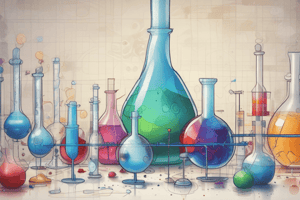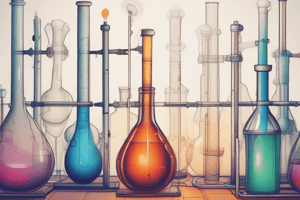Podcast
Questions and Answers
What is the purpose of the eluent in chromatography?
What is the purpose of the eluent in chromatography?
- To carry the analyte through the column (correct)
- To detect the analyte
- To separate the components of the mixture
- To purify the sample
What is the purpose of chromatography in pharmaceutical industry?
What is the purpose of chromatography in pharmaceutical industry?
- To identify the components of a mixture
- To analyze the components of a mixture
- To determine the amount of each chemical found in a new product (correct)
- To separate the components of a mixture
What is the term for the fluid that exits the column?
What is the term for the fluid that exits the column?
- Eluent
- Solvent
- Mobile phase
- Eluate (correct)
What is linear velocity in chromatography?
What is linear velocity in chromatography?
What is the retention time in chromatography?
What is the retention time in chromatography?
What is the primary use of chromatography in scientific research?
What is the primary use of chromatography in scientific research?
Which of the following organizations may use chromatography to detect blood or alcohol levels in a patient's bloodstream?
Which of the following organizations may use chromatography to detect blood or alcohol levels in a patient's bloodstream?
What is the primary purpose of Gas Chromatography?
What is the primary purpose of Gas Chromatography?
What is the function of the antibody in Radioimmunoassay (RIA)?
What is the function of the antibody in Radioimmunoassay (RIA)?
What is the purpose of the standard curve in Radioimmunoassay (RIA)?
What is the purpose of the standard curve in Radioimmunoassay (RIA)?
Which of the following types of chromatography separates dried liquid samples with a liquid solvent and a paper strip?
Which of the following types of chromatography separates dried liquid samples with a liquid solvent and a paper strip?
What is the primary purpose of Radioimmunoassay (RIA)?
What is the primary purpose of Radioimmunoassay (RIA)?
What is the function of the radiolabeled antigen (tracer) in Radioimmunoassay (RIA)?
What is the function of the radiolabeled antigen (tracer) in Radioimmunoassay (RIA)?
Which of the following types of chromatography separates liquid samples with a liquid solvent and a column composed of solid beads?
Which of the following types of chromatography separates liquid samples with a liquid solvent and a column composed of solid beads?
Which of the following fields is NOT commonly associated with RIA?
Which of the following fields is NOT commonly associated with RIA?
What is a limitation of RIA?
What is a limitation of RIA?
What is the primary purpose of PCR?
What is the primary purpose of PCR?
What is the role of primers in PCR?
What is the role of primers in PCR?
What is the temperature range for the annealing step in PCR?
What is the temperature range for the annealing step in PCR?
What is the enzyme responsible for synthesizing new DNA strands in PCR?
What is the enzyme responsible for synthesizing new DNA strands in PCR?
What is the result of the denaturation step in PCR?
What is the result of the denaturation step in PCR?
Who developed the PCR technique?
Who developed the PCR technique?
What is the ideal temperature for human polymerase to work?
What is the ideal temperature for human polymerase to work?
In which direction does the Taq polymerase add DNA bases to the single strand?
In which direction does the Taq polymerase add DNA bases to the single strand?
Which type of PCR amplifies RNA sequences?
Which type of PCR amplifies RNA sequences?
What is a limitation of PCR?
What is a limitation of PCR?
What is the purpose of heating the reaction mixture to 94-95°C in PCR?
What is the purpose of heating the reaction mixture to 94-95°C in PCR?
What is the function of the primers in PCR?
What is the function of the primers in PCR?
What is the purpose of an enzyme in an enzyme immunoassay?
What is the purpose of an enzyme in an enzyme immunoassay?
What is the primary application of EIAs in medical research?
What is the primary application of EIAs in medical research?
What is the temperature range for the annealing step in PCR?
What is the temperature range for the annealing step in PCR?
How many primers are used in PCR?
How many primers are used in PCR?
What is the advantage of PCR in terms of time?
What is the advantage of PCR in terms of time?
Why is the Taq DNA polymerase enzyme used in PCR?
Why is the Taq DNA polymerase enzyme used in PCR?
What is the result of the denaturation step in PCR?
What is the result of the denaturation step in PCR?
Which type of PCR monitors amplification in real-time?
Which type of PCR monitors amplification in real-time?
What is the purpose of the extension step in PCR?
What is the purpose of the extension step in PCR?
What is the temperature used in the extension step of PCR?
What is the temperature used in the extension step of PCR?
Flashcards are hidden until you start studying
Study Notes
Chromatography
- Chromatogram is the visual output of a chromatograph, which separates mixtures into individual components.
- Chromatograph is equipment that enables sophisticated separation of mixtures.
- Retention time is the characteristic time it takes for a particular analyte to pass through the system under set conditions.
- Eluent is the solvent that carries the analyte, while eluate is the fluid exiting the column.
- Elution is the process of passing the mobile phase through the column.
- Flow rate is the measure of how much mobile phase passes through the column per minute (ml/min).
- Linear velocity is the distance passed by the mobile phase per minute in the column (cm/min).
Uses of Chromatography
- Analyze: Examine a mixture, its components, and their relations to one another.
- Identify: Determine the identity of a mixture or components based on known components.
- Purify: Separate components to isolate one of interest for further study.
- Quantify: Determine the amount of the mixture and/or components present in the sample.
- Real-life examples: Pharmaceutical, hospital, law enforcement, and environmental agency applications.
Types of Chromatography
- Liquid Chromatography: Separates liquid samples with a liquid solvent (mobile phase) and a column composed of solid beads (stationary phase).
- Gas Chromatography: Separates vaporized samples with a carrier gas (mobile phase) and a column composed of a liquid or solid beads (stationary phase).
- Paper Chromatography: Separates dried liquid samples with a liquid solvent (mobile phase) and a paper strip (stationary phase).
- Thin-Layer Chromatography: Separates dried liquid samples with a liquid solvent (mobile phase) and a glass plate covered with a thin layer of alumina or silica gel (stationary phase).
Radioimmunoassay (RIA)
- RIA is a laboratory technique used to measure the concentration of a specific antigen or hormone in a sample.
- It is a highly sensitive and specific method that uses radioactivity to detect and quantify the binding of antibodies to antigens.
- Principle: Preparation, incubation, separation, measurement, and calibration.
- Widely used in various fields, including endocrinology, immunology, infectious disease diagnosis, and cancer research.
- Limitations: Radioactive material handling requirements, limited shelf life of radiolabeled tracers, and potential for non-specific binding.
Polymerase Chain Reaction (PCR)
- PCR is a laboratory technique used to make many copies of a specific DNA sequence.
- Steps: Denaturation, annealing, extension, and repeat.
- PCR is a powerful tool in molecular biology, used for DNA cloning, genetic testing, and forensic analysis.
- PCR has five core 'ingredients': DNA template, primers, DNA nucleotide bases, Taq polymerase enzyme, and a buffer.
- Types of PCR: Conventional PCR, Real-time PCR (qPCR), Reverse Transcription PCR (RT-PCR), and Multiplex PCR.
- Applications: Genetic testing, gene expression analysis, forensic analysis, cancer research, and viral load detection.
- Advantages: High sensitivity, high specificity, and fast results.
- Limitations: Contamination risk and inhibitors.
Enzyme Immunoassay (EIA)
- EIA is a type of immunoassay that uses an enzyme bonded to an antigen or antibody to detect specific molecules in a sample.
- Types of EIA: Enzyme-linked immunosorbent assay (ELISA), Enzyme multiplied immunoassay technique (EMIT), Fluorescent enzyme immunoassays (FEIAs), Chemiluminescent immunoassays (CLIAs), and Radioimmunoassays (RIAs).
- EIAs are widely used in medical and research applications for measuring protein, pathogens, and other molecules in blood samples.
Studying That Suits You
Use AI to generate personalized quizzes and flashcards to suit your learning preferences.




